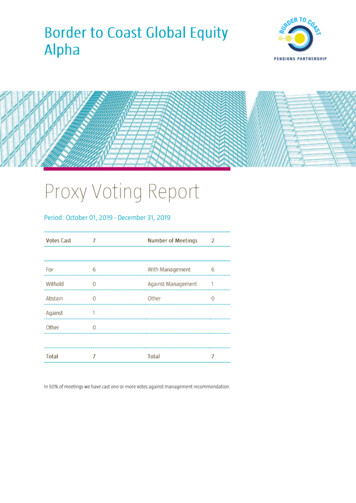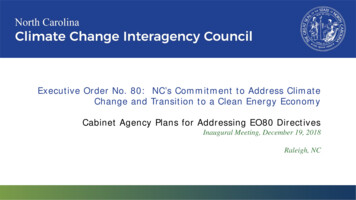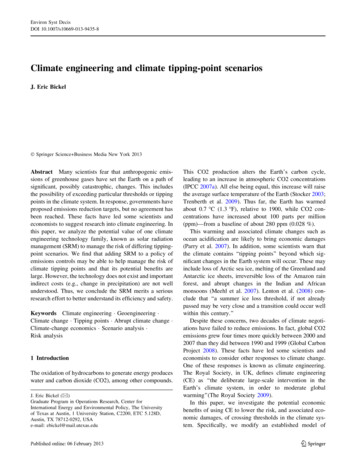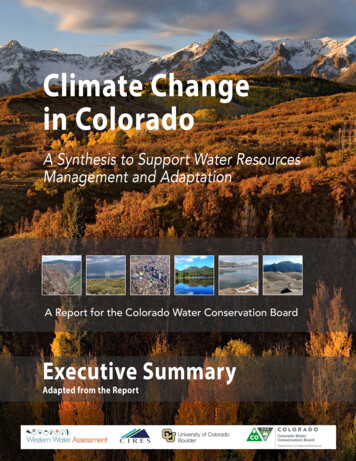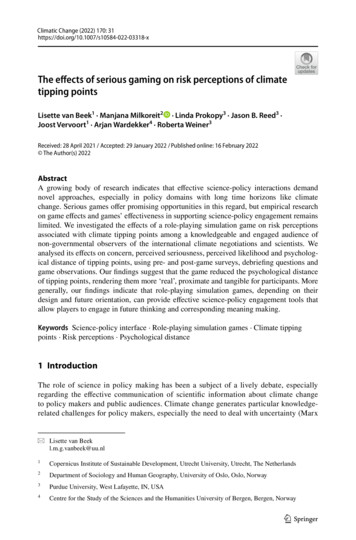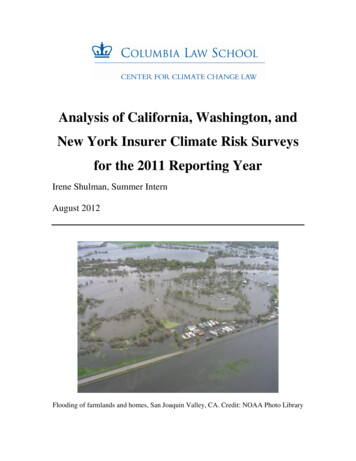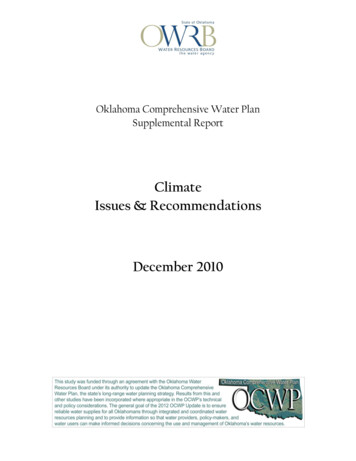
Transcription
Oklahoma Comprehensive Water PlanSupplemental ReportClimateIssues & RecommendationsDecember 2010
Climate Issues and RecommendationsThe following report was developed for the 2012 Update of the OklahomaComprehensive Water Plan to address Oklahoma climate issues as they relate to watermanagement. This analysis, conducted by the Oklahoma Climatological Survey, detailsthe anticipated climate-related water management challenges facing the state and offersrecommendations for future related research and development.
Oklahoma Climatological SurveyThe Oklahoma Climatological Survey (OCS; http://climate.ok.gov) was established by theState Legislature in 1980 to provide climatological services to the people of Oklahoma. TheSurvey maintains an extensive array of climatological information, operates the OklahomaMesonet, and hosts a wide variety of educational outreach and scientific research projects.Section 1, Chapter 63, O.S.L. 1982 (74 O.S. 2006, Section 245) outlines the powers andduties of the Oklahoma Climatological Survey. Under that act, the Survey is to: Acquire, archive, process, and disseminate, in the most cost-effective way possible,all climate and weather information that is or could be of value to policy anddecision makers in the state; Act as the representative of the state in all climatological and meteorologicalmatters both within and outside of the state when requested by the legislative orexecutive branches of the state government; Prepare, publish, and disseminate periodic regular climate summaries for thoseindividuals, agencies, and organizations whose activities are related to the welfareof the state and are affected by climate and weather; Conduct and report on studies of climate and weather phenomena of significantsocioeconomic importance to the state; Evaluate the significance of natural and man-made, deliberate and inadvertentchanges or modifications in important features of the climate and weatheraffecting the state, and to report this information to those agencies andorganizations in the state who are likely to by affected by such changes ormodifications; and Maintain and operate the Oklahoma Mesonetwork, a statewide environmentalmonitoring network which is overseen by the Mesonet Steering Committee,comprised of representatives of the University of Oklahoma and Oklahoma StateUniversity according to its Memorandum of Agreement.The Oklahoma Mesonet (http://weather.ok.gov) is a world-class network of environmentalmonitoring stations operated by the Oklahoma Climatological Survey. The network wasdesigned and implemented by scientists at the University of Oklahoma and at OklahomaState University. The Mesonet consists of 120 automated stations covering Oklahoma.Mesonet stations report real-time weather and climate information every five minutesfrom every county in Oklahoma. The Mesonet’s infrastructure allows for the OWRB toinstall groundwater depth sensors at several sites (e.g., El Reno, Fittstown) at no recurringcost and for federal programs, such as the Agriculture Research Service, to fund andcollaborate with OCS on watershed monitoring for water resources research.OCS leads the Southern Climate Impacts Planning Program (SCIPP), a Regional IntegratedSciences and Assessments program funded by the National Oceanic and AtmosphericAdministration (NOAA). SCIPP’s research goal is to help communities better plan forweather and climate-related disasters in the southern United States, particularly in the faceof changing climate. Focusing on the six-state study region of Oklahoma, Texas, Louisiana,Arkansas, Tennessee, and Mississippi, SCIPP concentrates on the high frequency of1
hazardous climatological events that plague the region including extremes in precipitation(e.g., droughts and floods) as well as other hazards including severe storms and hurricanes.OCS scientists also led the development and implementation of EarthStorm, a results-basedK-12 teacher enhancement program that brought authentic learning about weather and itsimpacts to classrooms statewide, and OK-First, a weather education program and decisionsupport system for the state’s public safety officials, predominantly emergency managers.OCS climatologists worked with the National Drought Mitigation Center to prototype amaterials kit for towns and cities to become a Drought-Ready Community, modeled afterthe successful Storm-Ready Community program of NOAA’s National Weather Service.OCS serves a dual role as an expert in Oklahoma’s current and past climate as well as anactive listener to the needs of our state’s citizens, state agencies, tribal nations, cities, andother stakeholders. We value our partners throughout the state, combining expertise, keyrelationships, and resources to address our state’s weather and climate challenges. OCS’sdata, products, and services are used to document the history of Oklahoma’s climate andprovide context to current weather events; save lives and property through preparation forand response to natural disasters; decrease costs for agricultural producers throughlivestock- and crop-specific decision tools; provide a competitive advantage for Oklahomaresearchers and businesses through high-quality data; and educate schoolchildren and thepublic about weather, weather safety, and climate.Oklahoma’s climateWeather is the state of the atmosphere with respect to heat or cold, wetness or dryness,calm or storm, clearness or cloudiness. Climate is the statistical collection of weatherconditions (e.g., averages, extremes) at a place over a period of years. In addition to thecomposition of gases in the atmosphere, the climate of an area is primarily affected by itslatitude, elevation, proximity to a large water body (e.g., Gulf of Mexico), and the prevailingwinds. Terrain, vegetation, smaller water bodies, and other more localized physicalconditions can affect the climate of any specific location.The mean annual temperature over the state ranges from 62 F along the Red River to about58 F along the northern border. It then decreases westward to 56 F in Cimarron County.Temperatures of 90 F or greater occur, on average, about 60-65 days per year in thewestern panhandle and the northeast corner of the state. The average is about 115 days insouthwest Oklahoma and about 85 days in the southeast. Temperatures of 100 F or higheroccur, frequently during some years, from May through September, and very rarely in Apriland October. Except for most of the panhandle, the western half of Oklahoma averages 15days or more with temperatures of 100 F or higher, ranging from about 35 days in thesouthwest corner to 25 in the northwest. The eastern half of the state and most of thepanhandle average less than 15 days of triple-digit temperatures. Years without 100 Ftemperatures are rare, ranging from about one of every seven years in the eastern half ofthe state to somewhat rarer in the west.Precipitation provides an estimated 127 million acre-feet of renewable water each year to2
Oklahoma, founding the state’s water budget. The dominant feature of the spatialdistribution of rainfall across Oklahoma (Figure 1) is a sharp increase in rainfall from west( 17 inches) to east ( 56 inches), helping to support more ecosystems than all but oneother U.S. state. Excessive daily rainfall of 8 inches or more, while rare, has been recorded.Recently, however, several 500-year events have been observed by the Oklahoma Mesonet,including at Oklahoma City on June 14, 2010 (10.0 inches over 12 hours); Burneyville onApril 29, 2009 (28.9 inches over 1 day); and Fort Cobb on August 19, 2007 (7.4 inches over3 hours).Extreme precipitation events pose a substantial risk to lives and property, especially inareas prone to flash flooding. In fact, since 2000, flooding was involved in 13 PresidentialDisaster Declarations in Oklahoma (overseen by FEMA). Overall, Oklahoma has had moreMajor Disaster Declarations than any other state since 2000. Flash flooding claimed 13lives in Oklahoma from 2000-2010. Heavy rainfall also is associated with enhanced soilerosion as well as increased leaf and root pathogens in vegetation. Although these highflow events typically capture the headlines, the other end of the water-availabilityspectrum –– drought –– is arguably more economically devastating. Drought is associatedwith agricultural crop and pasture damage (both quality and quantity), increasedresidential water demand, increased risk of wildfire and smoke-related respiratorydiseases, and differential mortality and morbidity in forest species. Low streamflowassociated with drought affects water quality as well as quantity. Since 2000, drought wasinvolved in 14 declared disasters by the U.S. Department of Agriculture where one or moreOklahoma counties were listed as “primary natural disaster areas.”Floods of major rivers and tributaries may happen during any season, but they occur withgreatest frequency during those spring and autumn months associated with greatestrainfall. Such floods cost many lives and property damage during the first 50 years ofstatehood, but flood prevention programs have reduced the frequency and severity of suchevents. Flash flooding of creeks and minor streams remains a serious threat, especially inurban and suburban areas, where urban development and removal of vegetation haveincreased runoff.3
Drought is a recurring part of Oklahoma's climate cycle, as it is in all the Plains states.Almost all of Oklahoma's usable surface water comes from precipitation that falls withinthe state's borders. Therefore, drought in Oklahoma is tied almost entirely to local rainfallpatterns (i.e., the influence of upstream events on drought is very small). WesternOklahoma is slightly more susceptible to drought because precipitation there tends to bemore variable (percentage-wise) and marginal for dryland farm applications.Drought episodes can last from a few months to several years. Those that last a few monthscan elevate wildfire danger and impact municipal water use. Seasonal droughts can occurat any time of the year, and those that coincide with crop production cycles can causebillions of dollars of damage to the farm economy. Multi-season and multi-year episodescan severely impact large reservoirs, streamflow and groundwater.Annual average relative humidity ranges from about 60 percent in the panhandle to justover 70 percent in the east and southeast. On average, cloudiness increases from west toeast across Oklahoma. Average annual lake evaporation varies from 48 inches in theextreme east to 65 inches in the southwest, numbers that far exceed the average yearlyrainfall in those areas. Evaporation and percolation into the soil expend about 80 percent ofOklahoma's precipitation.Prevailing winds are from the south to southeast throughout most of the state from thespring through autumn months. These prevailing winds typically are from the south tosouthwest in far western Oklahoma, including the panhandle. The winter wind regime isroughly equal split between northerly and southerly winds.On average, thunderstorms occur about 55 days per year in eastern Oklahoma, decreasingto about 45 days per year in the southwest. The annual rate increases to near 60 daysannually in the extreme western panhandle. Late spring and early summer are the peakseasons for thunderstorms. December and January, on average, feature the fewest4
thunderstorms.Tornadoes are a particular hazard in Oklahoma. Since 1950, an average of 54 tornadoeshave been observed annually within the state’s borders. Tornadoes can occur at any time ofyear, but are most frequent during springtime. Three-fourths of Oklahoma’s tornadoeshave occurred during April, May, and June. May's average of 20 tornado observations permonth is the greatest. The winter months each average less than one tornado per month.Climate-related water challenges in Oklahoma’s future“Warming of the climate system is unequivocal, as is now evident from observations ofincreases in global average air and ocean temperatures, widespread melting of snow and ice,and rising global average sea level.” – the Fourth Assessment of the IntergovernmentalPanel on Climate Change (IPCC)That statement reflects the essence of a vast amount of observational data and climateresearch: the earth’s climate has warmed on average during the last 100 years and willvery likely continue to warm through the 21st century. Further, ample evidence fromobservational data and climate modeling studies indicates that this global-scale warming isnot attributable to natural variability.OCS has conducted a review of the current assessments of climate change research andconcludes the following to be true: The earth’s climate has warmed during the last 100 years; The earth’s climate will very likely continue to warm for the foreseeable future; Much of the global average temperature increases over the last 50 years can beattributed to human activities, particularly increasing greenhouse gases in theatmosphere; and Oklahoma will be impacted.In particular, climate change is projected to continue to alter the water cycle across the U.S.,including the total amount of annual precipitation, timing of the precipitation, precipitationintensity and frequency, and location of precipitation. Nationwide, most locations alreadyhave experienced increases in both precipitation and streamflow and decreases in droughtduring the second half of the 20th Century.The U.S. Global Climate Research Program (USGCRP) projects that more frequent heavyrainfall events and droughts will affect much of the Great Plains as climate changes. TheUSGCRP notes, “Projections of increasing temperatures, faster evaporation rates, and moresustained droughts brought on by climate change will only add more stress to overtaxedwater sources.”A variable precipitation history (Figure 2) and an uncertain future under climate changecombine to challenge even the most forward-thinking and resourceful managers ofresources and infrastructure. With precipitation intensity projected to increase acrossmuch of the United States, recent statements that “stationarity is dead” verbalize concernsthat the added uncertainty of climate change, as well as questions about the ability of global5
climate models to produce realistic precipitation extremes, will confound the alreadyuncertain results from extreme value statistics for long return periods (e.g., 100 years andlonger).Recommendations for Future Research and DevelopmentFunding for the following recommendations can be developed through a combination ofpermanent state funding for the Oklahoma Climatological Survey, project-based funding viaresearch grants and contracts from external agencies (e.g., National Science Foundation;U.S. Departments of Agriculture, Energy, and Interior; National Oceanic and AtmosphericAdministration), and stable funding provided by water or energy users via a small increasein water permit fees or monthly surcharge on electrical bills.1. Oklahoma should assess the characteristics of, variability of, and trends inmoisture and temperature over a range of spatial and temporal scales and use thisinformation to enhance and validate regional climate projections from seasonal todecadal time scalesThe complexity of Oklahoma’s water environment results, in part, from the type ofprecipitation that occurs across our state. Much of Oklahoma’s precipitation is convectivein nature, resulting in isolated thunderstorms, lines or complexes of multiplethunderstorms, and embedded thunderstorms in winter low-pressure systems. These6
convective events result in river floods, flash floods, significant ice storms, and theoccasional blizzard. On the other end of the water-supply spectrum are seasonal to multiyear droughts. Better physical understanding of these events (e.g., how are precipitationconditions related to El Niño and La Niña?, what conditions led to more devastating icestorms in the decade of the 2000s than any previous decade since statehood?) is critical toknowing how our water environment will change in the future. Additional research isneeded on the characteristics of, variability of, and trends in moisture and temperatureover a range of spatial and temporal scales. This information can be used to enhance thephysical mechanisms depicted in regional climate models and to validate the results of bothhigh-resolution and “downscaled” global climate models for the goal of providing decisionmakers the best projections possible for resource management and infrastructuredecisions. In addition, the water demands for each watershed, whether from ecosystemservices, residential usage, agriculture, energy development, or other need, needs to beassessed at a variety of temporal scales to determine the resiliency of the system to suddenor slow changes in “normal” precipitation. This knowledge results from learning howindividuals, organizations, and communities prioritize water usage and what conditionstrigger them to conserve water.2. Oklahoma should develop and improve predictive water management toolsEven without the population growth, climate change, and land use changes that areprojected in the future, Oklahoma water resource managers are plagued by too few toolsthat display current supply and demand, near-term and long-term projections inprecipitation, and comparison with past water years. It is difficult to manage risk withoutsufficient information and tools.Water resources management is governed by the interrelationships between the weatherand climate system, natural and engineered water systems, and water use decisions.Understanding the variability and trends of our past water budget (e.g., precipitation,evaporation, soil moisture fluxes, groundwater recharge, runoff) and the use of globalclimate models is only a first step. A similar effort is needed to assess trends and variabilityin water demand at local and regional scales. What are the primary drivers behindincreasing water use or conservation? How do economics (i.e., the cost of providing water)affect individual judgments on conservation? How can other factors, such as aestheticqualities (e.g., lakes, green vegetation), be valued and how do they affect our water usedecisions? How are changes in the natural ecosystems affecting water demand, such asexpansive spread of eastern redcedars? How does new technology affect water use (e.g.,expanded use of dishwashers)?Once identified, these factors can be coupled into a decision-support model that allowscommunity planners and water district managers to alter one or more of the inputs to seehow the system responds. This tool will give local planners an ability to determine optionsthat preserve local supplies at the lowest possible cost and maintain community qualitythat residents deem important. Tools such as WaterSim, developed by Arizona StateUniversity, are a start in this direction, allowing water managers to adjust factors such asclimate change, drought, population growth, technological innovation, land use, and policydecisions. But these are designed for large urban areas on highly managed water systems7
like the Colorado River. Oklahoma could become a leader in developing a tool that worksfor small, rural communities that rely primarily upon local lakes, streams, and reservoirs.3. Oklahoma should measure and account for its waterCurrently, Oklahoma is the most comprehensively observed state in the U.S. with respect towater in both the atmosphere and near-surface soil layer. Our observing capabilitiesprovide us high potential to conduct a comprehensive, statewide “water census” on themonthly, seasonal, and annual time scales. Maintaining a strong infrastructure of theOklahoma Mesonet, in combination with federal resources such as the Doppler radarnetwork, is critical for accounting for water supply, especially through extremes in ourclimate. Some water elements, especially on the watershed level, need to be bettermeasured or estimated and others that may be measured well by remote sensingtechnologies may require further validation of algorithms. Many of these additionalelements can be funded through research grants, but funding for the Oklahoma Mesonetnecessitates the permanent base funding by the Oklahoma Legislature (through theOklahoma State Regents for Higher Education), with annual cost-of-living adjustments.Without this stable funding, the Oklahoma Mesonet cannot provide the water resourcemanagement, operations, education, and research communities with the observationsneeded to conduct business efficiently and effectively.8
collaborate with OCS on watershed monitoring for water resources research. OCS leads the Southern Climate Impacts Planning Program (SCIPP), a Regional Integrated Sciences and Assessments program funded by the National Oceanic and Atmospheric Administration (NOAA). SCIPP's research goal is to help communities better plan for
